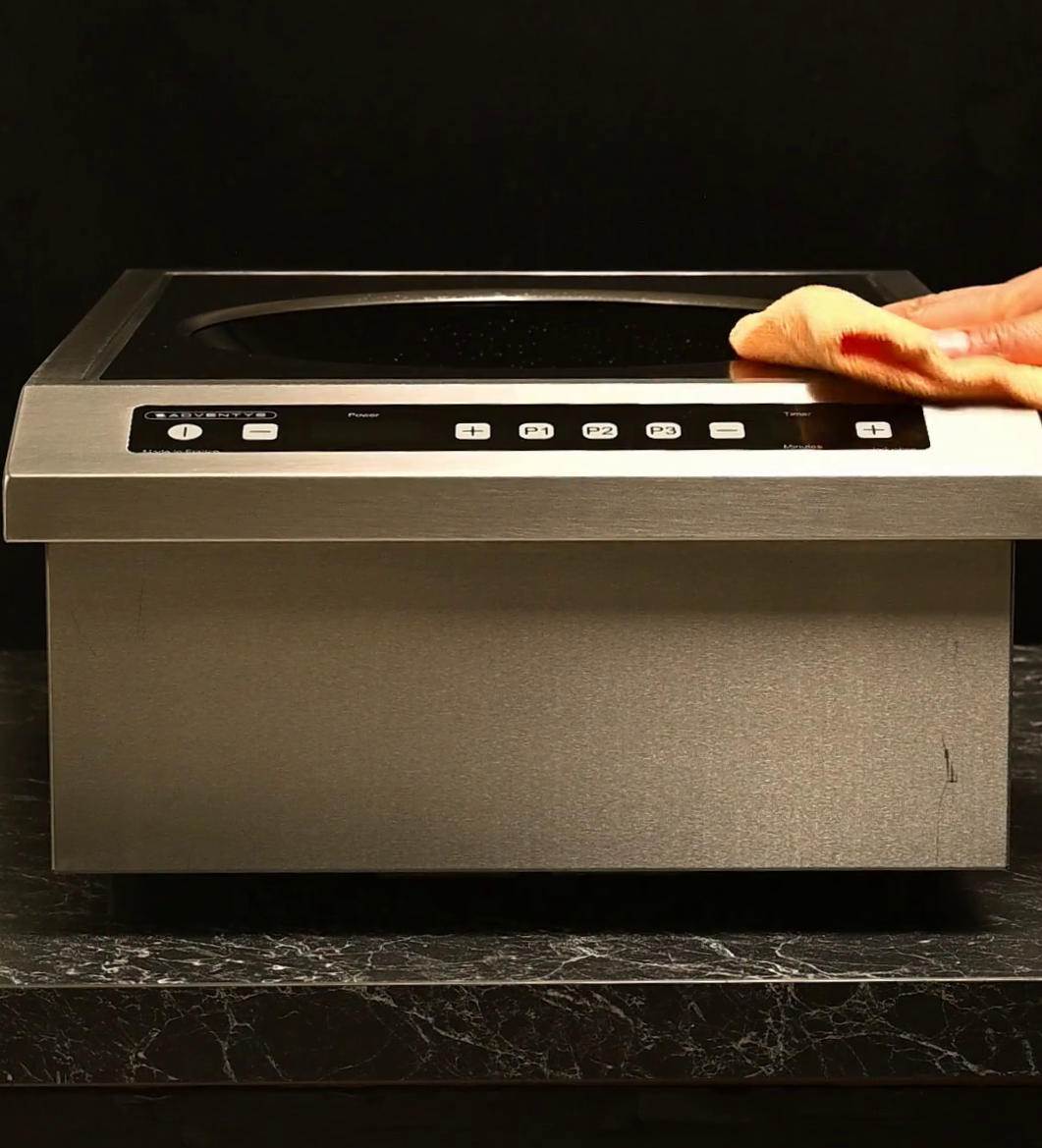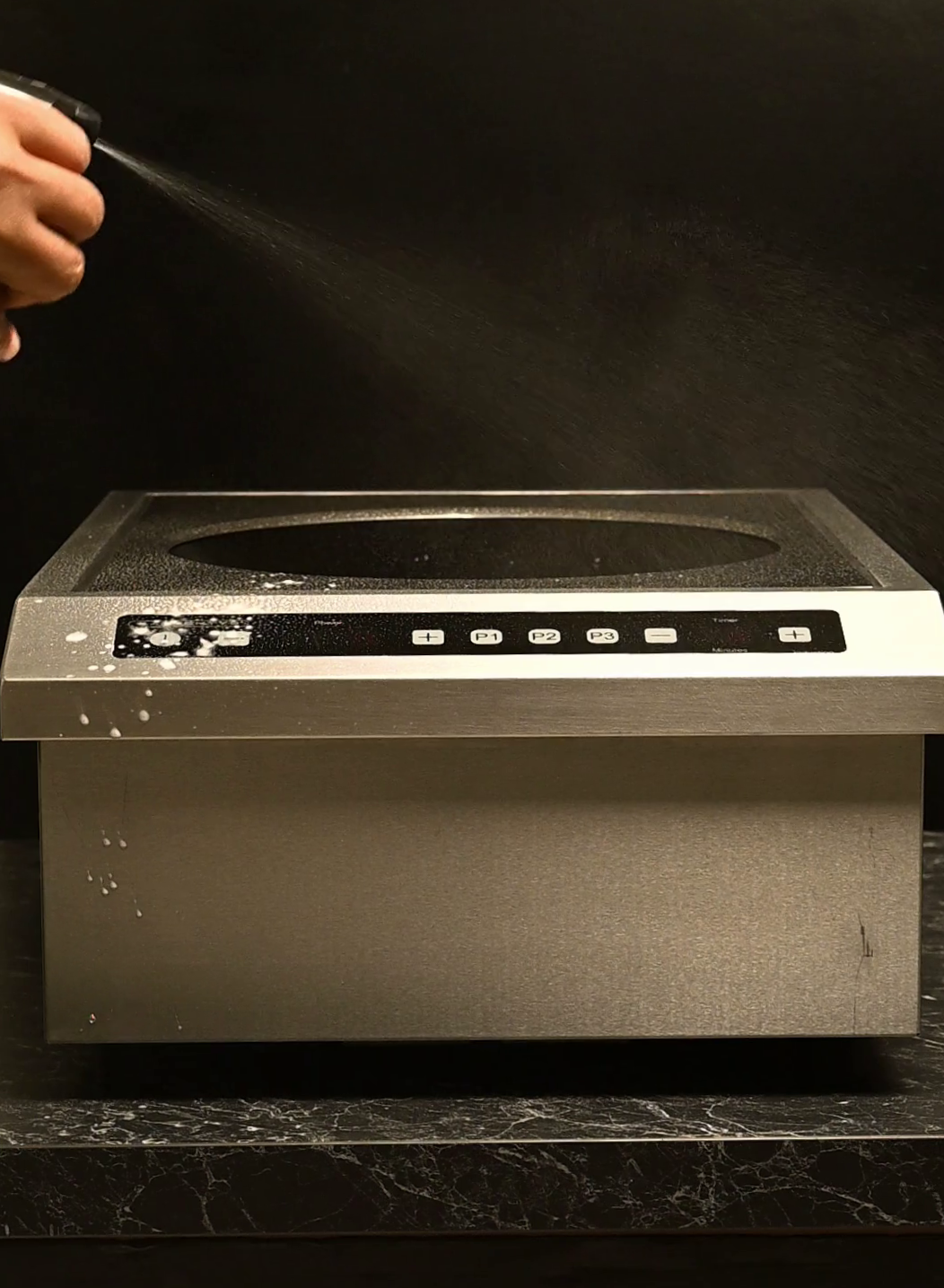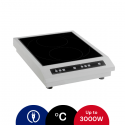Les erreurs à éviter pour préserver la performance de votre plaque induction
Erreur 1 : Sous-estimer l'entretien de la plaque à induction
Résidus brûlés, rayures disgracieuses, taches tenaces… La négligence est le pire ennemi de votre plaque de cuisson. Lorsqu'elle manque d'entretien, la table à induction n'est pas seulement inesthétique, elle devient aussi moins performante.
Pour garder une plaque impeccable même après des années d'utilisation, nettoyez-la après chaque utilisation. Patientez bien que la surface refroidisse avant de passer un chiffon avec du vinaigre blanc. Adieu graisses et taches rebelles qui tuent votre plaque à petit feu. Pour protéger le verre des rayures, ne nettoyez jamais cette surface avec le côté abrasif de l'éponge.
Utilisez plutôt un chiffon en microfibres, plus doux, mais tout aussi efficace. Pour préserver votre appareil des éclaboussures et autres accidents en cuisine, pensez à l'équiper d'un protège plaque en verre – très pratique pour prévenir les petits pépins du quotidien !

Erreur 2 : Mal utiliser ses ustensiles
D'ores et déjà, retenez qu'une plaque à induction ne fonctionne pas avec n'importe quelle poêle ou casserole. Notez également qu'un fond trop fin ou un matériau inadapté peut altérer l'efficacité de la cuisson à induction. Bref, pour que votre plaque dure des années sans broncher, commencez par vous équiper des bons ustensiles.
Certes, une batterie de cuisine de qualité est indispensable pour le bon fonctionnement de votre table de cuisson. Cependant, cela ne suffit pas pour l'épargner de l'usure et des dysfonctionnements. Pour prolonger la durée de vie de votre plaque à induction, vous devez adopter des gestes simples, mais essentiels :
- Lavez correctement vos ustensiles pour éliminer les résidus incrustés ;
- Séchez-les soigneusement avant chaque utilisation ;
- Déposez vos poêles, casseroles et marmites en douceur sur la plaque, même lorsque vous êtes pressé ;
- Ne faites jamais glisser vos ustensiles sur la plaque au risque de rayer la surface en verre ;
- Ne laissez jamais d'ustensile sur la table de cuisson, surface chauffée ou non ;
- N'utilisez jamais votre plaque comme support pour d'autres objets.
Erreur 3 : Nettoyer sa plaque induction avec des produits inappropriés
Un entretien régulier, oui, mais uniquement avec les bons produits de nettoyage ! L'utilisation de solutions inadaptées peut avoir des conséquences fâcheuses sur votre appareil, qui sont, pour la plupart, irréversibles. Pour vous donner une idée, cela peut laisser des traces, affecter le système de cuisson, réduire la performance des foyers, voire endommager le champ magnétique.
Premiers ennemis de votre plaque de cuisson à induction : les nettoyants abrasifs. Les poudres à récurer, produits à base de javel ou toute autre solution agressive attaque la surface vitrocéramique et la fragilise. Optez plutôt pour des solutions douces et naturelles comme le vinaigre blanc, qui est un super dégraissant et un antitache maison.
Vous pouvez également mélanger du bicarbonate de soude avec un peu d'eau pour traiter les résidus tenaces sans risquer de rayer votre belle plaque en verre. Un chiffon en microfibre humide suffit ensuite pour rincer et faire briller votre table de cuisson comme au premier jour !
Erreur 4 : Utiliser les commandes et options de cuisson sans faire attention
Au rythme des innovations technologiques, les tables de cuisson à induction s'enrichissent constamment de nouvelles fonctionnalités. Des commandes innovantes et pensées pour la performance voient le jour, mais sont souvent difficiles à prendre en main. Conséquences : des réglages inadaptés, des options inutiles, une surconsommation énergétique… et l'usure prématurée de l'appareil.
De plus, votre table de cuisson n'est pas la seule victime ; les dégâts se font sentir autant sur la plaque que dans l'assiette : cuissons irrégulières, aliments brûlés, débordements, etc. Bref, lorsqu'elle est mal utilisée, une plaque à induction complique plus la tâche qu'elle n'aide au quotidien.
Ainsi, si vous voulez que votre appareil dure dans le temps, apprenez à bien l'utiliser. Sachez que chaque option a été conçue pour un usage spécifique, alors avant d'appuyer au hasard, lisez attentivement le guide de l'appareil.
Erreur 5 : Sous-estimer l'installation et le branchement de sa plaque à induction
La plaque à induction nécessite une alimentation électrique adaptée, contrairement à d'autres appareils électroménagers. En effet, la plupart des tables à induction exigent une prise 32A capable de supporter une puissance élevée. D'autre part, si vous avez choisi une plaque encastrable, sachez que l'encastrement doit respecter des dimensions spécifiques.
Par ailleurs, l'appareil a besoin de suffisamment de ventilation pour éviter la surchauffe, principal responsable de dysfonctionnements. Enfin, l'installation doit impérativement répondre aux normes électriques en vigueur pour garantir l'efficacité et la sécurité du dispositif.
Pour toutes ces raisons, il est préférable, voire nécessaire, de confier la mise en place d'un système à induction à un professionnel qualifié. Quand bien même, vous choisirez d'installer votre table de cuisson seul, consultez attentivement le guide du fabricant et demandez conseil en cas de doute.
Erreur 6 : Mauvaise gestion du contrôle de la température
L’un des principaux atouts d’une plaque à induction est son contrôle précis de la température, qui permet d’adapter la cuisson en fonction des aliments. Cependant, une mauvaise gestion des niveaux de chauffe peut altérer la performance de la plaque et impacter la qualité de cuisson.
Utiliser une puissance trop élevée en continu peut provoquer une surconsommation énergétique. À l’inverse, une température trop basse peut allonger inutilement les temps de cuisson et réduire l’efficacité énergétique de l’induction. L’option "booster" doit être utilisée avec modération, uniquement pour une montée en température rapide, puis ajustée en fonction des besoins.
Pour préserver la longévité de votre plaque, il est recommandé de choisir la puissance adaptée à chaque type de cuisson :
Cuisson douce (sauces, chocolat, mijotés) : température basse et constante.
Saisir une viande ou faire bouillir de l’eau : puissance élevée sur une courte durée.
Maintien au chaud : puissance minimale pour éviter une consommation excessive.
Une bonne maîtrise du contrôle de la température garantit non seulement une cuisson homogène et précise, mais aussi une meilleure préservation de votre plaque à induction sur le long terme.

Ce qu'il faut retenir
Une plaque à induction performante, c'est avant tout une plaque bien entretenue, utilisée correctement et installée suivant les normes. Pour qu'elle dure le plus longtemps possible, nettoyez votre plaque avec des produits adaptés, familiarisez-vous avec les commandes et faites-vous accompagner par des installateurs professionnels.
Vous recherchez le nec-plus-ultra des systèmes à induction ? Découvrez la gamme de cuisson Adventys et équipez-vous d'une plaque aussi puissante que durable !
Partager ce contenu


